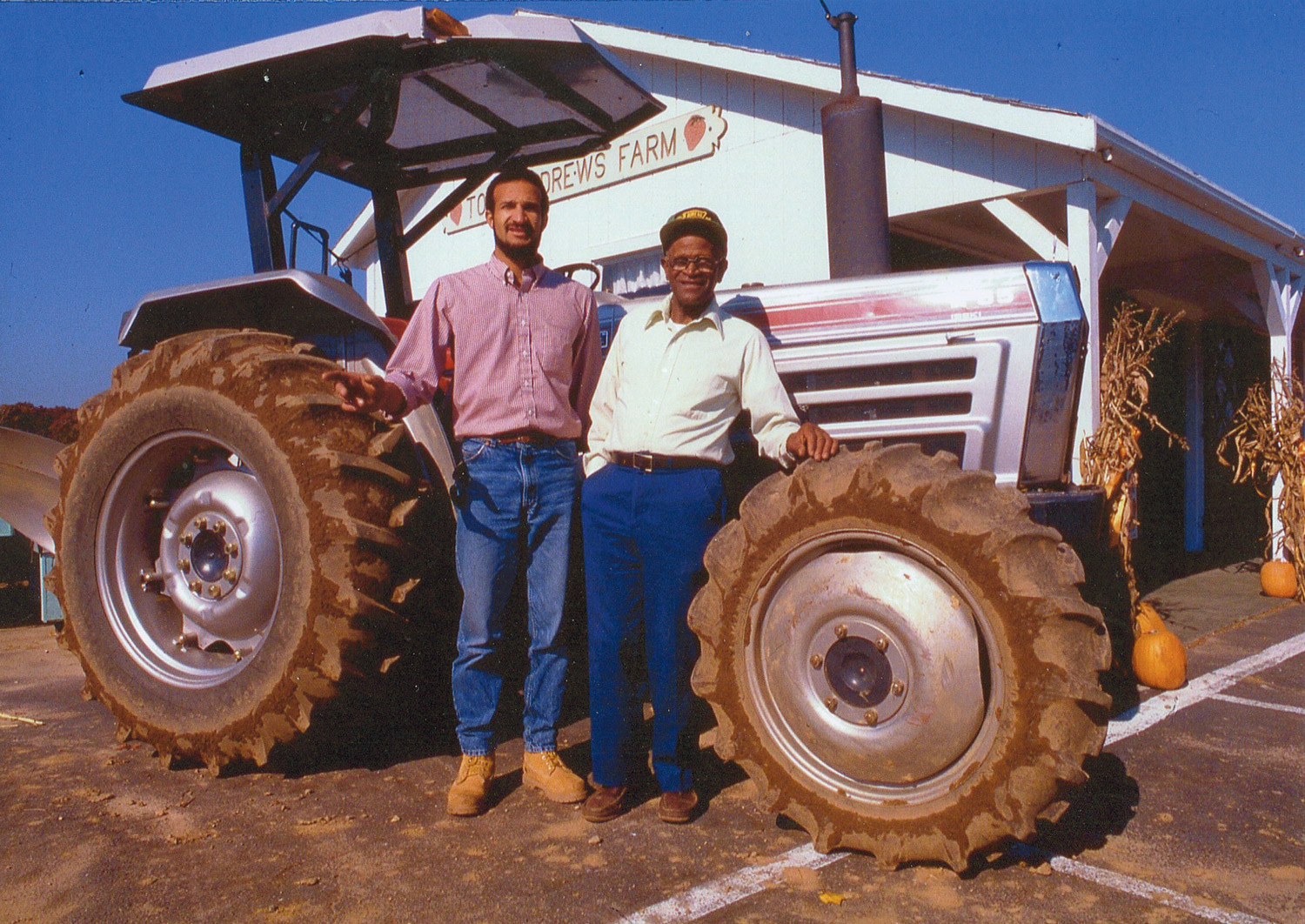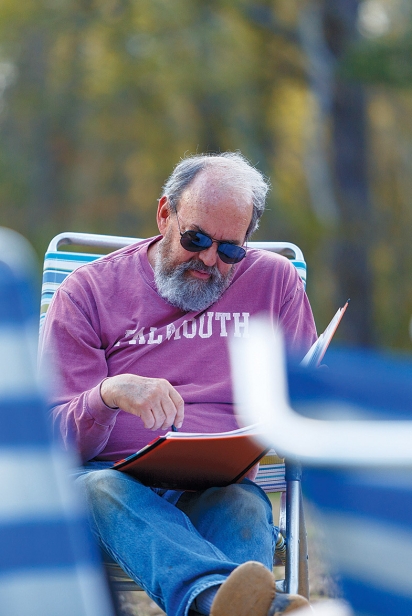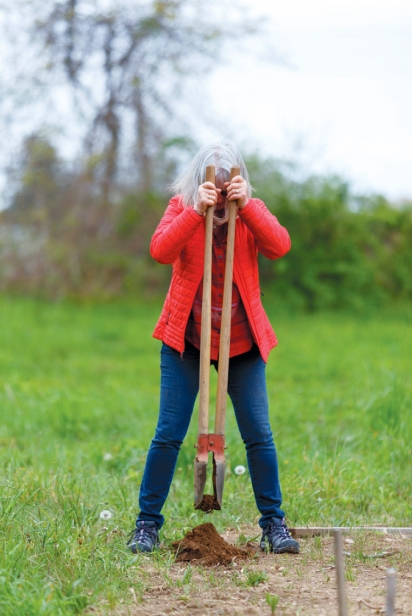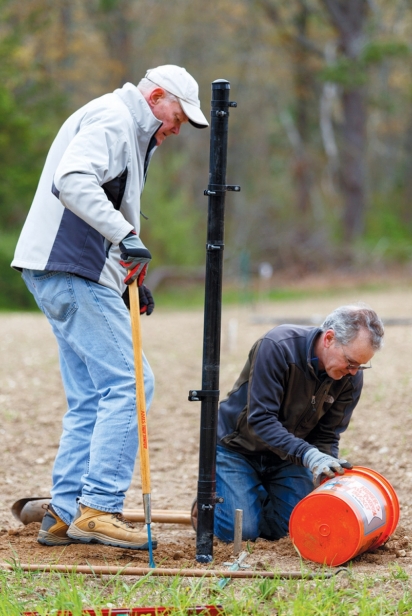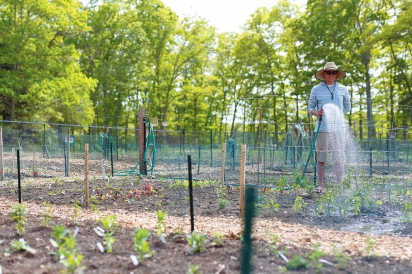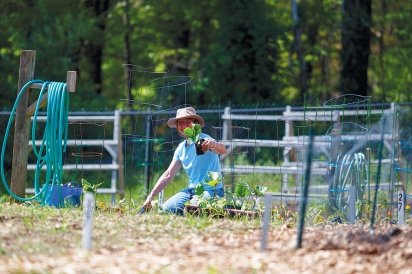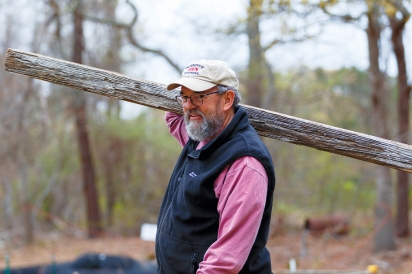Community Pride & a Garden Usher in a New Era for Tony Andrews Farm
It’s springtime on the Cape, which means weeks of rain interrupted only by relentless wind. On a blustery May morning, a handful of hardy volunteers lug fence posts across a freshly-tilled field, neatly divided by numbered stakes. With materials donated and salvaged from the Falmouth Service Center, they’re creating a new community garden on two acres at Tony Andrews Farm, on Old Meetinghouse Road in East Falmouth.
Within a week, the irrigation will be hooked up and the wood chip paths will be raked smooth, and local residents will start planting 65 garden plots in the first town-owned farm in Falmouth’s history. The physical work is just the tip of the iceberg, the culmination of three years of meetings, votes and grant applications, resulting in a unique partnership between the farmer, the town, the conservation land trust The 300 Committee, and Farming Falmouth, a nascent non-profit dedicated to preserving the town’s farmland.
As Farming Falmouth member Ilene Karnow dug one of sixty fence postholes, it marked the first time in nearly a century that someone other than an Andrews had worked the land. But it’s hardly the first time that a member of the community had gotten her hands dirty on the farm. For generations, residents have flocked to Tony Andrews Farm in June for pick-your-own strawberries and sugar snap peas, returning over the summer for sweet corn, sunflowers and onions, and a haunted hay ride and a fat orange pumpkin in time for Halloween.
For many in the community, a visit to Tony Andrews Farm has meant more than picking up veggies for dinner or entertaining the kids with a hayride. It has provided a connection to a time when Falmouth was more of a fishing and farming town, where Portuguese and Azorean immigrants like Tony Andrews could thrive. Born Antonio DeAndrade on the tiny island of Fogo, Andrews was a sailor on a schooner ship that—unbeknownst to him—made a one-way trip to Rhode Island in 1926. Stranded in the United States with few resources, Andrews and his uncle eventually bought land in Falmouth, clearing the trees by hand and working the local cranberry bogs to make ends meet. They planted strawberries and turnips and gradually became prosperous enough to expand the farm to 72 acres.
It was a good time to be a farmer. In the 1920s until well into the 1950s, Falmouth was the strawberry capital of the East. According to Bill Clark, who served as director of the Cape Cod Cooperative Extension and often worked with the Andrews family, farmers from Falmouth would load 20 million quarts of strawberries onto trains bound for Boston and Providence every year. The sandy, slightly acidic soil of farms that stretched across East Falmouth provided just the right conditions for strawberries, but Clark said that just about any crop—from corn to potatoes to tomatoes—did well.
After World War II, a new craze for industrialized food and a fewer people willing to work for low wages prompted many farmers on the Cape to sell their properties. That trend continued throughout Clark’s tenure with the Cooperative Extension, from 1978 to 2016.
“During that time I saw the Cape almost double in population. And as it did, a lot of the farms that were here became house lots. Andrews Farm is one of the exceptions,” Clark said. “It’s a symbol of the importance of family farms and generations staying in agriculture, not only in Falmouth but in our country. It provides a sense of community. That’s something that’s lost in our country today, unfortunately.”
Innovation in the face of changing times has perhaps been the key to Tony Andrews Farm’s survival. In the 50s, faced with a lack of farm workers (who historically hailed from the Azores), the Andrews came up with the idea of “pick your own” strawberries. Both Bill Clark and Tony Andrews’ youngest son, Geoff, say it was the first farm to do so with strawberry crops in Massachusetts. Not only did “pick your own” solve the labor problem, that hands-on farm experience became a rite of passage for generations of residents and visitors. To this day, the farm offers “pick your own” strawberries, sunflowers, tomatoes, peas and pumpkins, in addition to daily pickings in its farm stand.
After Tony Andrews’ passing in 2006, at the age of 102, his son Geoff took over operations. But in 2016, the Andrews family decided to put the property on the market—to the consternation of residents for whom the farm symbolizes Falmouth’s proud agricultural heritage.
That’s where innovation came in again. Desperate to save the farm from development, a working group of farmers, conservationists, and local foodists came up with an audacious proposal for the Town of Falmouth to purchase the 46-acre property. Under stewardship of the conservation land trust The 300 Committee, a strip of waterfront in the Coonamessett River Greenway would be placed under conservation restriction, and the rest would be a town-managed working farm. The working group knew that the roughly $3 million price tag might be hard for town meeting members to swallow, but felt it was worth a shot to save the last large farm in Falmouth.
“It’s a key piece of property to preserve for its agricultural value. You lose those primary soils to development and there’s nothing that can replace that. Those soils are one of our biggest natural resources,” said Karen Schwalbe, the current chairman of the Falmouth Agricultural Commission and executive director of the Southeastern Massachusetts Agricultural Partnership (SEMAP).
With only a smattering of debate, Falmouth town meeting members overwhelmingly supported the working group’s proposal in both the spring and fall town meetings of 2017. In February 2018, the town officially purchased the property, with significant contributions from The 300 Committee donors and a state Local Acquisitions for Natural Diversity (LAND) grant. All the working group had to do next was to find a farmer to keep the Andrews’ legacy alive. It turned out, they didn’t have to look far; after a request for proposals, they granted a 20- year lease to Geoff Andrews.
For Andrews, the shift from owner to tenant hasn’t been much of a lifestyle change. He still walks the fields each morning, and still plants peas the first week of April. Two years ago, Andrews started transitioning the farm to organic (it’s a seven-year process to become certified), but he said the prices in the farmstand won’t increase. (In addition to farm-grown produce, the stand also sells fruit grown on conventional farms.) If anything, Andrews said he hopes the partnership with the town will bring more visitors to the farm. They might only plan on walking their dog or tending their garden plot, but Andrews hopes a few will stay to pick strawberries or buy some corn.
“What the town wants is what I want, and what my dad wanted: always make sure the farm will stay a farm,” Andrews said. “Farming comes naturally to me. I love what I do, and I’m keeping my dad’s legacy alive.”
Schwalbe said a big part of the town’s decision to accept Geoff Andrews’ proposal was his knowledge of the property and proven history of operating a successful farm. Though Andrews will continue to farm a majority of the land, it was his idea to build the community garden and he will work with The 300 Committee and other community groups to host educational events.
“We need to increase our resiliency by having open land and people who know how to farm it,” Schwalbe said. “Farming and creating food creates real value in our society. The more we can engage the community in that process the more we’ll understand what it takes to feed yourself.”
In her work with SEMAP, Schwalbe said she has only seen a few examples in the state where a town has invested in preserving a working farm. “Falmouth has taken a bold step into preserving its agricultural heritage and making a commitment to continue farming. It was a heavy lift by the community. We have so much to be proud of,” she said.


